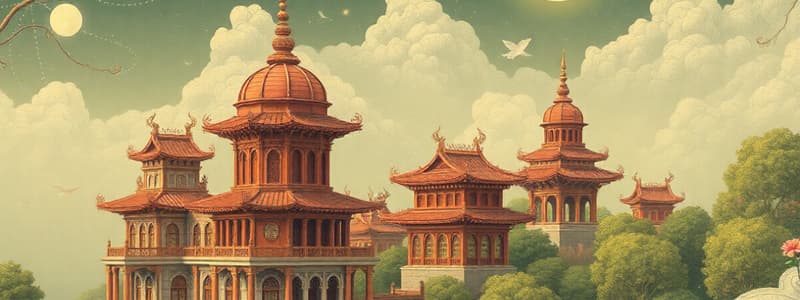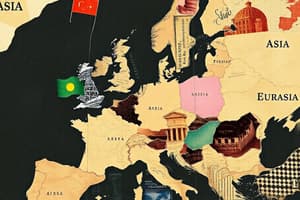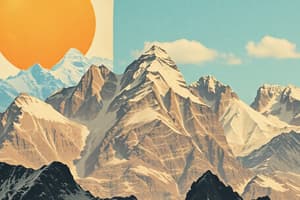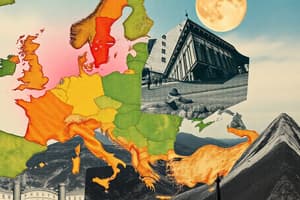Podcast
Questions and Answers
Which of the following countries have parts in both Asia and Europe?
Which of the following countries have parts in both Asia and Europe?
- India
- Turkey (correct)
- China
- Indonesia
Which of the following rivers is NOT primarily associated with Asia?
Which of the following rivers is NOT primarily associated with Asia?
- Indus
- Amazon (correct)
- Ganges
- Yangtze
Which country is expected to become the world's largest economy by 2027?
Which country is expected to become the world's largest economy by 2027?
- China (correct)
- South Korea
- India
- Japan
What percentage of the total land area does Asia cover?
What percentage of the total land area does Asia cover?
Which of the following cities is NOT mentioned as a major financial center in Asia?
Which of the following cities is NOT mentioned as a major financial center in Asia?
Which of the following religions originated in Western Asia?
Which of the following religions originated in Western Asia?
What is a significant economic advantage that companies gain by operating in developing countries in Asia?
What is a significant economic advantage that companies gain by operating in developing countries in Asia?
Which of the following does NOT describe Asia's economy?
Which of the following does NOT describe Asia's economy?
What significant event occurred in Japan in 1993 related to its political landscape?
What significant event occurred in Japan in 1993 related to its political landscape?
Which event closely followed the election results in August 2009?
Which event closely followed the election results in August 2009?
What major disaster struck Japan in March 2011, and what was its consequence?
What major disaster struck Japan in March 2011, and what was its consequence?
Which leader replaced Keizo Obuchi following his stroke in 2000?
Which leader replaced Keizo Obuchi following his stroke in 2000?
What was the status of Japan's economy at the end of the 1990s?
What was the status of Japan's economy at the end of the 1990s?
What is the term length for members elected to the House of Councilors in Japan?
What is the term length for members elected to the House of Councilors in Japan?
How are the deputies of the State Duma in Russia elected?
How are the deputies of the State Duma in Russia elected?
Which of the following accurately describes the political structure of the Russian Federation?
Which of the following accurately describes the political structure of the Russian Federation?
Who holds the position of Supreme Commander-in-Chief of the Armed Forces in Russia?
Who holds the position of Supreme Commander-in-Chief of the Armed Forces in Russia?
How many seats are in the House of Representatives in Japan?
How many seats are in the House of Representatives in Japan?
What significant event occurred on December 12, 1993, in Russian history?
What significant event occurred on December 12, 1993, in Russian history?
Who is recognized as the head of state of the Russian Federation?
Who is recognized as the head of state of the Russian Federation?
How frequently are members elected to the House of Representatives in Japan?
How frequently are members elected to the House of Representatives in Japan?
What is required for the appointment of the Chairman of the Government in Russia?
What is required for the appointment of the Chairman of the Government in Russia?
Which constitutional responsibility does the President of Russia NOT hold?
Which constitutional responsibility does the President of Russia NOT hold?
What power does the President of Russia have regarding legislation?
What power does the President of Russia have regarding legislation?
Which city is NOT one of the federal entities of the Russian Federation?
Which city is NOT one of the federal entities of the Russian Federation?
Which body does the President submit nominations for the Constitutional Court judges?
Which body does the President submit nominations for the Constitutional Court judges?
What is the highest office held within the Russian Federation?
What is the highest office held within the Russian Federation?
Which of the following is NOT a power of the President of Russia?
Which of the following is NOT a power of the President of Russia?
Who is the current President of the Russian Federation?
Who is the current President of the Russian Federation?
What significant economic changes occurred in China starting in the late 1970s?
What significant economic changes occurred in China starting in the late 1970s?
What was the average annual growth rate of China's GNP after the reform and opening began?
What was the average annual growth rate of China's GNP after the reform and opening began?
Which geographic feature is prominent in southwestern China?
Which geographic feature is prominent in southwestern China?
Why do most of China's population reside in the southern and seaboard regions?
Why do most of China's population reside in the southern and seaboard regions?
Which rivers are considered the lifelines of China?
Which rivers are considered the lifelines of China?
What percentage of China's population is considered part of the Han ethnic group?
What percentage of China's population is considered part of the Han ethnic group?
When was China first unified as a singular state?
When was China first unified as a singular state?
What impact did political centralization have on China's diverse cultures?
What impact did political centralization have on China's diverse cultures?
What factor contributed to the Communist victory over the KMT in 1949?
What factor contributed to the Communist victory over the KMT in 1949?
What was the primary reason the United States recognized the KMT government in Taiwan until 1979?
What was the primary reason the United States recognized the KMT government in Taiwan until 1979?
What modernization approach did the CCP adopt after establishing the PRC?
What modernization approach did the CCP adopt after establishing the PRC?
What was a key aspect of the Hundred Flowers campaign of 1956?
What was a key aspect of the Hundred Flowers campaign of 1956?
How did Mao respond to the liberalization effects of Soviet de-Stalinization?
How did Mao respond to the liberalization effects of Soviet de-Stalinization?
What major challenge faced the new Communist regime in China?
What major challenge faced the new Communist regime in China?
Which event marked the end of Stalin's leadership in the Soviet Union?
Which event marked the end of Stalin's leadership in the Soviet Union?
What did the PRC assert about Taiwan?
What did the PRC assert about Taiwan?
Flashcards
What is Asia's size?
What is Asia's size?
Asia is the largest continent by land area, covering 8.8% of the Earth's total landmass.
What is Asia's geographic significance?
What is Asia's geographic significance?
It is the largest continent with the largest coastline, covering nearly four-fifths of the total of Eurasia.
Where is Asia located?
Where is Asia located?
It is situated west of the Suez Canal and Ural Mountains, north of the Arctic Ocean, east of the Pacific Ocean, and south of the Indian Ocean.
What is Asia's economic significance?
What is Asia's economic significance?
Signup and view all the flashcards
Why are businesses attracted to Asia?
Why are businesses attracted to Asia?
Signup and view all the flashcards
What are Asia's major financial centers?
What are Asia's major financial centers?
Signup and view all the flashcards
Why are India and China major outsourcing hubs?
Why are India and China major outsourcing hubs?
Signup and view all the flashcards
What is significant about Asia's religious origins?
What is significant about Asia's religious origins?
Signup and view all the flashcards
Reform and Opening
Reform and Opening
Signup and view all the flashcards
China's Economic Growth
China's Economic Growth
Signup and view all the flashcards
Han Chinese
Han Chinese
Signup and view all the flashcards
Southwestern China
Southwestern China
Signup and view all the flashcards
Northeastern China
Northeastern China
Signup and view all the flashcards
Southern and Coastal China
Southern and Coastal China
Signup and view all the flashcards
China's Lifelines
China's Lifelines
Signup and view all the flashcards
Cultural Homogenization
Cultural Homogenization
Signup and view all the flashcards
LDP's fall from power
LDP's fall from power
Signup and view all the flashcards
Kobe Earthquake
Kobe Earthquake
Signup and view all the flashcards
Japanese Recession
Japanese Recession
Signup and view all the flashcards
Succession of Japanese Prime Ministers
Succession of Japanese Prime Ministers
Signup and view all the flashcards
DPJ's victory
DPJ's victory
Signup and view all the flashcards
What is the Japanese bicameral legislature called?
What is the Japanese bicameral legislature called?
Signup and view all the flashcards
What is the lower house of the Japanese Diet called?
What is the lower house of the Japanese Diet called?
Signup and view all the flashcards
What is the upper house of the Japanese Diet called?
What is the upper house of the Japanese Diet called?
Signup and view all the flashcards
What is the legislative branch of the Russian Federation called?
What is the legislative branch of the Russian Federation called?
Signup and view all the flashcards
What is the lower house of the Russian Federal Assembly called?
What is the lower house of the Russian Federal Assembly called?
Signup and view all the flashcards
What is the upper house of the Russian Federal Assembly called?
What is the upper house of the Russian Federal Assembly called?
Signup and view all the flashcards
Who is the head of state in the Russian Federation?
Who is the head of state in the Russian Federation?
Signup and view all the flashcards
What is the executive branch of the Russian Federation called?
What is the executive branch of the Russian Federation called?
Signup and view all the flashcards
Establishment of the PRC
Establishment of the PRC
Signup and view all the flashcards
Challenges for the New Regime
Challenges for the New Regime
Signup and view all the flashcards
Soviet Model of Modernization
Soviet Model of Modernization
Signup and view all the flashcards
CCP Suppressing Opposition
CCP Suppressing Opposition
Signup and view all the flashcards
China's Divergence from the Soviet Model
China's Divergence from the Soviet Model
Signup and view all the flashcards
De-Stalinization in the Soviet Union
De-Stalinization in the Soviet Union
Signup and view all the flashcards
The Hundred Flowers Campaign
The Hundred Flowers Campaign
Signup and view all the flashcards
CCP's Critique of Soviet De-Stalinization
CCP's Critique of Soviet De-Stalinization
Signup and view all the flashcards
What is the Constitution of the Russian Federation?
What is the Constitution of the Russian Federation?
Signup and view all the flashcards
Who is the President of the Russian Federation?
Who is the President of the Russian Federation?
Signup and view all the flashcards
What is the Government of Russia?
What is the Government of Russia?
Signup and view all the flashcards
What role does the President play in ensuring legality?
What role does the President play in ensuring legality?
Signup and view all the flashcards
What powers does the President have in appointing officials?
What powers does the President have in appointing officials?
Signup and view all the flashcards
What is the President's role in the lawmaking process?
What is the President's role in the lawmaking process?
Signup and view all the flashcards
What is the Federation Council?
What is the Federation Council?
Signup and view all the flashcards
What is the State Duma?
What is the State Duma?
Signup and view all the flashcards
Study Notes
Asian Political Systems
- Asia has a geographically significant position and importance in global strategic thought, acting as a gateway due to cultural depth, vast energy resources, and a large population.
- Asia has historically been a central arena for international leadership struggles, particularly during the Cold War, with geopolitical competition.
- Asia possesses substantial economic, geographical, and cultural capabilities, influencing global politics.
- East Asia has shown remarkable indicators of human development, with China leading the "Top 10 Movers" list based on income growth since 1970.
- Asia covers about 8.8% of the total land area, the largest with the largest coastline and includes 48 countries, some of which extend into Europe.
Demographics
- East Asia has displayed substantial advancements in human development over the last four decades.
- China has made significant progress in income, leading to its inclusion in "Top 10 Movers" rankings,
- No other country except India has a similar large population as China's, with 1.3 billion people.
- Improved life expectancy has been shown in Nepal, and Japan and South Korea rank among the top countries in terms of the Human Development Index.
Economy
- Asia holds a significant position in the world economy, having the second-highest nominal GDP.
- Major economies within Asia include India, China, Japan, Indonesia, and South Korea.
- Global Office Locations 2011 showed that Asia dominated office locations with 4 out of 5 of the top locations within Asia.
- China is anticipated to have the highest GDP by 2027.
Natural Resources
- Asia is the largest continent with a substantial amount of natural resources, including forests, fish, water, copper, rice, petroleum, and other minerals.
- The manufacturing sector in Eastern and Southeast Asia is strong.
- Major financial centers are Hong-Kong, Tokyo, Shanghai, and Singapore, attracting many English-speaking workers and drawing in financial centers.
Religions
- Judaism, Islam, and Christianity originated in Western Asia.
- Indian philosophies (Hinduism, Buddhism, Jainism, and Sikhism)
- Confucianism, Zen Buddhism, and Taoism originated in East Asia.
Regions
- North Asia encompasses the Russian Federation, known for oil and gas exports.
- East Asia comprises China, Mongolia, Taiwan, Japan, North Korea, and South Korea; it is the main industrial region.
- South Asia includes India, Nepal, Bangladesh, and Pakistan, often considered the poorest region; with India as an industrial center.
- Southeast Asia consists of Thailand, Vietnam, Philippines, Malaysia, and Indonesia, relying heavily on agriculture.
- West Asia (Middle East) includes KSA, Kuwait, Iraq, Lebanon, and Jordan, and is notable for its substantial oil reserves.
- Central Asia includes Kazakhstan, Kyrgyzstan, Tajikistan, Turkmenistan, and Uzbekistan, which possess valuable resources.
China
- China's history spans over 4,000 years, shaping its modern society and politics profoundly.
- China has a huge population, with over 1.3 billion people.
- China has a wide range of climatic and topographic features.
- The Yellow and Yangtze rivers are important to the country's agriculture.
- The Han ethnic group dominates the population of China.
- The political paradox in China involves how a country with ancient centralization and early political centralization could become weak by the 19th century, lacking the capacity to resist Western Imperialism.
- Important historical periods include the Shang dynasty, Qin dynasty, Qing dynasty, First Opium War, May Fourth movement, the Chinese Civil War, and the founding of the People's Republic of China.
- China's economic reforms in the late 1970s led to unprecedented growth and made it a global economic power.
- The country's growth was marked by rapid industrialization and economic reform.
- The Cultural Revolution (1966-1976) disrupted and disrupted social and political life.
Japan
- Japan experienced two atomic bomb attacks in 1945, leading to surrender and the occupation by the USA
- It adopted a new constitution renouncing war and establishing a parliamentary system
- Japanese economy significantly developed following the war with a notable rise of the car industry.
- The LDP dominated the political scene, with some interludes from other parties.
- There was severe recession in the 1990s and an earthquake in Kobe in 1995.
Russia
- Russia is a democratic federal republic, with a bicameral legislature (the State Duma and the Federation Council).
- The President of Russia is the head of state and head of the armed forces.
- The Government of Russia is the chief executive branch of the country. The current president is Vladimir Putin.
Studying That Suits You
Use AI to generate personalized quizzes and flashcards to suit your learning preferences.




